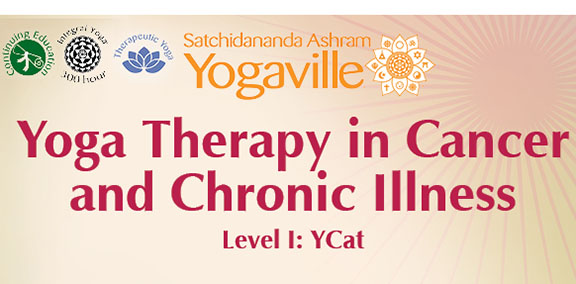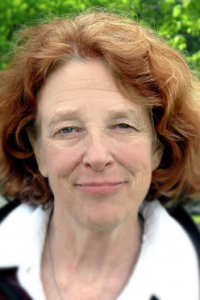 A gifted Integral Yoga teacher, massage therapist, stress management specialist, and registered nurse, Jnani Chapman developed the “Yoga Therapy in Cancer & Chronic Illness” Teacher Training (YCat) program. She tragically passed away in a car accident in 2017. In this interview from 2004 she talked about her certification program then and the tools needed to face our mortality.
A gifted Integral Yoga teacher, massage therapist, stress management specialist, and registered nurse, Jnani Chapman developed the “Yoga Therapy in Cancer & Chronic Illness” Teacher Training (YCat) program. She tragically passed away in a car accident in 2017. In this interview from 2004 she talked about her certification program then and the tools needed to face our mortality.
Integral Yoga Magazine: In your brochure, you say that Swami Satchidananda’s teachings provide the basis for the program.
Jnani Chapman: For me, one of the core principles in Integral Yoga is connecting to that center of deep peace that is always there within—that sea of peace that is eternal and unchanging. When someone has a direct experience of that, then the waves in life are easier to ride. Integral Yoga helps people deal with the stress of a cancer diagnosis and treatment by helping them connect with that peace within.
Michael Lerner, who founded the Commonweal Cancer Help Program, and Dean Ornish, who developed the Heart Disease Reversal Program, are longtime students of Sri Gurudev. Gurudev encouraged them to bring Yoga to people dealing with cancer and heart disease. He instilled in them the courage to do this work. And, I feel the same blessing with my work.
IYM: Can you give us an overview of your program?
JC: I expect the Yoga teachers who come to take the program to be certified already in some school of Yoga. I help those not trained in Integral Yoga learn how to teach the breathing practices, deep relaxation, meditation, even chanting. Many traditions don’t even teach breathing practices. Physical postures and movements are important, but they are not the whole story. For people with cancer, who have significant limitations, the physical postures and movements may be very uncomfortable initially, and even intimidating. So, if asana instruction is the only thing in a teacher’s bag of tricks, he or she is going to be at a loss to help someone who is dealing with a diagnosis of cancer.
IYM: How do you prepare teachers to deal with those limitations and other issues?
JC: People who have just been given a cancer diagnosis will likely experience anxiety and depression. They may feel distanced from the life around them. They may not feel “normal” inside. If a Yoga teacher is just focused at the asana level, he or she is going to miss what is really going on for a person, and that can cause harm—unintentional harm, but harm nonetheless.
So, besides presenting didactic information to help the teacher understand what is going on for the student, physically and biologically, the program offers experiential processes to help teachers connect with their own feelings and their own traumas and struggles. It is, after all, the ability to experience and know what it really going on within ourselves that allows us to be present for somebody else.
IYM: What kind of benefits have you seen in the cancer patients with whom you work?
JC: The immortal nature of the soul is something that many religious traditions speak about—and that the body is transient and temporary. In Yoga we chant, “Lead us from unreal to real. Lead us from darkness to the light. Lead us from the fear of death to the knowledge of immortality.”
Buddhists talk about the irony that most people realize that everyone else is going to die, but they never think of their own impermanence. When a person is diagnosed with cancer, he or she is faced directly with mortality. Yoga helps people find a deeper level of knowing from within. People burdened with anxiety and tension find a place that they might not have known existed within them. This helps give them a sense of how they can carry on in the face of mortality. I realized I am only one person and there are many people who could benefit from these practices. So, it became important to me not just to teach but to train others to teach.
IYM: Would you tell us more about this program?
JC: At least half of the teachers who come to the program want to know mainly which poses are innately healing, or even curing and which poses are contraindicated. For me, thinking along those lines is dangerous. It is not that simple. You can’t just say, “Do these poses. Don’t do these poses.” There are hundreds of variations of Yoga poses and thousands of adaptations. There has been little research to tell us, “here, do this,” or “don’t do that.”
After having worked with people with cancer now for almost 20 years, I can share my experiences. What I want to do, primarily, is to broaden the way the teacher is thinking, so that instead of looking for a list of “do this” or “don’t do that,” they are understanding processes—what goes on in the body with cancer and its treatment.
IYM: How do you do that?
JC: I present a lot of education for people about what cancer is. It’s a systemic disease. But every cancer is different. And, even the same cancers manifest very differently for different people. But, if the teacher understands the dynamic processes operating in the body, mind, and the emotions; it is more than just anatomy and physiology. It is moving into pathophysiology and psycho-neuroimmunology—understanding body systems, the disease process, and the body’s responses as well as the nature of the mind and its reactions.
We spend a lot of time educating the teachers so that they are seeing below the surface. They are understanding from their own experience, and from a conceptual framework. For example, you could have a number of different people with metastatic breast cancer which has spread through the circulatory system, and set up home in another organ or in the bones. Each one may present very differently, with different needs. So, even with the same group, at the same stage of illness, there are adaptations in the physical and nonphysical Yoga practices that you, as a teacher, are going to need to make to serve that person, based on what you see and what you know.
IYM: How do you teach that to teachers?
JC: First, students come to part one, which is both experiential and didactic. Then, in order to be certified, the participants intern with me. When they go back to their communities, they begin to set up classes for people with cancer, and I mentor them by phone and e-mail. Any time that they are doing an eight or twelve week course class, I am available to them. They interview each student and develop a very close therapeutic relationship, so that the person who has cancer is able to be open about what is going on, physically, emotionally, and mentally. The teacher develops a care plan from this intake process and we talk out how to adapt the basic structure of a class to meet the needs of each of the individual students.
IYM: What happens after they complete the internship?
JC: Part three of the certification program may happen before they have completed their internship. Participants attend a symposium at Yogaville where they staff a retreat for people with cancer. I serve as a staff member on the retreat but the teachers present the program. It is a marvelous thing. It is held at the Lotus Conference Center, a private retreat center separated from the main part of the Ashram. It provides a sense of safety, protection, and seclusion. The people who are dealing with cancer have this safety net of support. A protective bubble is created where they can be out on the grounds, enjoying nature during their free time, or they can be in the Yoga room, taking Yoga classes. They enjoy meals together.
IYM: Are you hopeful that programs such as this will have a positive impact on the medical community?
JC: There are many changes that people are working on to make medicine more humane. I think that medicine welcomes complementary therapy because of its benefits. The patients who come to my classes love what they experience, and they love having tools in their pocket to help make a difference in their lives. They can use those stress-relieving tools, anywhere—in the waiting room, waiting for the report back from some test, or in the grocery store, waiting on line. They are then going to their physicians and saying, “This is what is helping me.” And, thankfully, those physicians are listening
About Jnani Chapman:
 Jnani Chapman, RN, was the stress management specialist nurse for both the Breast Cancer Complementary Support Program at the University of California at San Francisco as well as the California Pacific Medical Center’s Institute of Health & Healing. Jnani was the massage coordinator for the Smith Center Cancer Help Program in Washington, D.C., and the Commonweal Cancer Help Program in Bolinas, Calif., which was featured on the award-winning PBS special, Bill Moyer’s Healing and the Mind. As a cardiac rehabilitation nurse, she was one of the original Yoga teachers for Dr. Dean Ornish’s Program for Reversing Heart Disease. She staffed his Preventive Medicine Research Institute Retreats held at the Claremont Resort & Spa throughout the 1990s. As a post-graduate researcher at the School of Nursing at UCSF, Jnani co-conducted a research study for Symptom Management, which showed that several acupressure points applied with a Yyoga breathing practice were significant in reducing the nausea associated with AC and CMF chemotherapy regimens for women with breast cancer.
Jnani Chapman, RN, was the stress management specialist nurse for both the Breast Cancer Complementary Support Program at the University of California at San Francisco as well as the California Pacific Medical Center’s Institute of Health & Healing. Jnani was the massage coordinator for the Smith Center Cancer Help Program in Washington, D.C., and the Commonweal Cancer Help Program in Bolinas, Calif., which was featured on the award-winning PBS special, Bill Moyer’s Healing and the Mind. As a cardiac rehabilitation nurse, she was one of the original Yoga teachers for Dr. Dean Ornish’s Program for Reversing Heart Disease. She staffed his Preventive Medicine Research Institute Retreats held at the Claremont Resort & Spa throughout the 1990s. As a post-graduate researcher at the School of Nursing at UCSF, Jnani co-conducted a research study for Symptom Management, which showed that several acupressure points applied with a Yyoga breathing practice were significant in reducing the nausea associated with AC and CMF chemotherapy regimens for women with breast cancer.
To donate to the Jnani Chapman Memorial Scholarship fund, please visit: www.commonweal.org/news/memoriam-jnani-chapman
For more information about Ycat and their current programs, please visit: www.yogaforpeoplewithcancer.com

